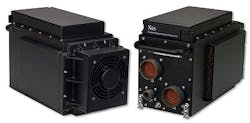Sub-half-ATR embedded computing enclosure for vetronics and avionics introduced by X-ES
MIDDLETON, Wis., 10 Feb. 2012. Extreme Engineering Solutions Inc. (X-ES) is introducing the XPand4201 sub-half-ATR forced-air-cooled embedded computing enclosure for conduction-cooled modules in military embedded systems and similar applications like command, control, communications, computers, intelligence, surveillance, and reconnaissance; avionics; vetronics; helicopters; fixed-wing aircraft; and unmanned vehicles.
The XPand4201 conducts heat from conduction-cooled modules to heat exchangers, and then dissipates the heat to the ambient environment by forced-air cooling. A heat exchanger on top of the XPand4201 enhances cooling.
Because the design supports conduction-cooled boards in an air tight enclosure, the XPand4201 provides enhanced shock and vibration protection and isolation of the boards from the outside environment, X-ES officials say.
As many as five conduction-cooled, 0.8-inch-pitch 3U VPX payload modules and one 3U VPX power supply module can be configured into chassis, which measures 5.88 inches by 6 inches by 13.5 inches. The system has an optional removable memory module that supports the XPort6192 removable solid-state disk (SSD), which has 256 gigabytes of encrypted storage capacity. With the memory module attachment the height increases to 7.62 inches.
The XPand4201 can be configured for custom I/O with conduction-cooled PMC/XMC modules. It also supports 10-Gigabit Ethernet, Gigabit Ethernet, graphics, RS-232/RS-422, MIL-STD-1553, ARINC 429, CANbus, CameraLink, GPIO, and digital and analog I/O.
An optional front-panel USB port supports system monitoring and maintenance. Several power supply options are available to support a MIL-STD-704 28-volt DC or 115-volt AC input, as well as internal EMI filtering.
For more information contact X-ES online at www.xes-inc.com.

